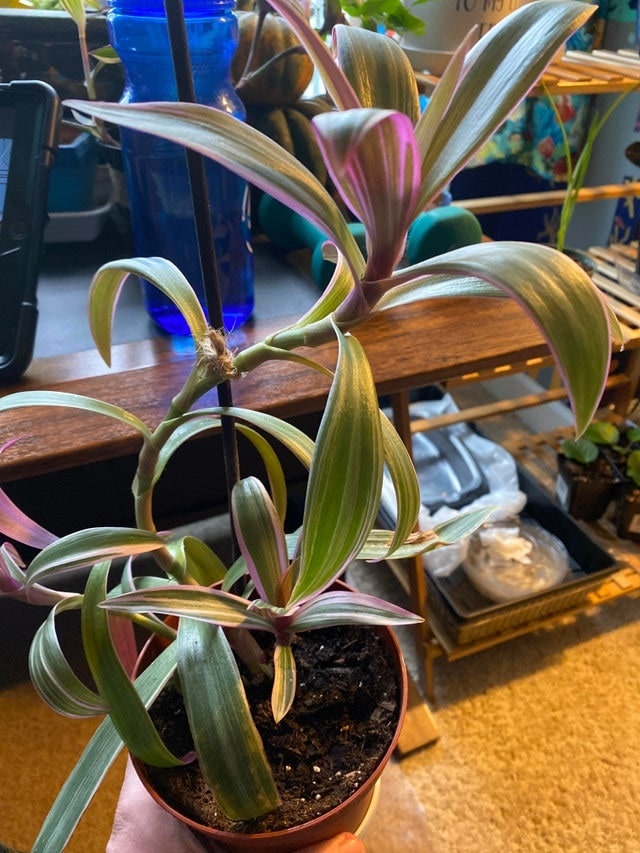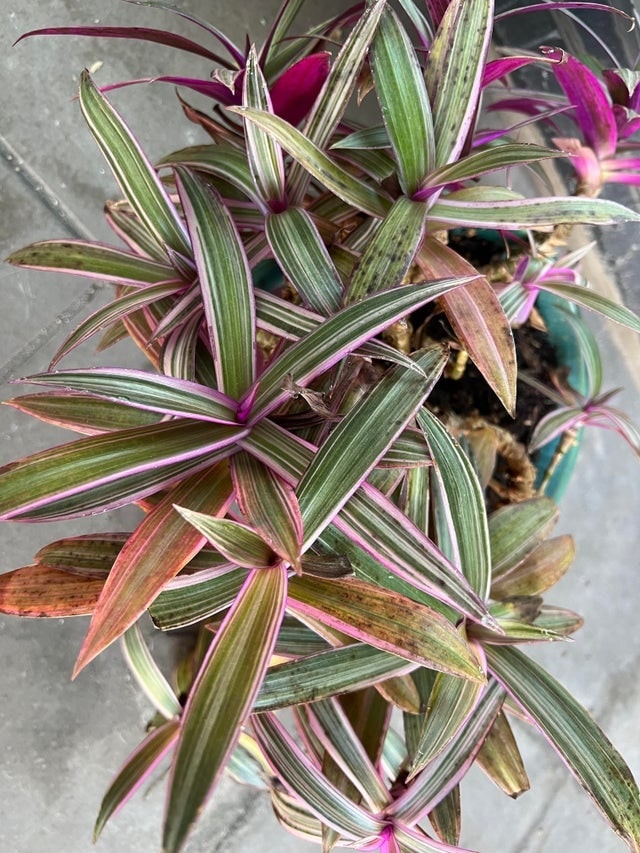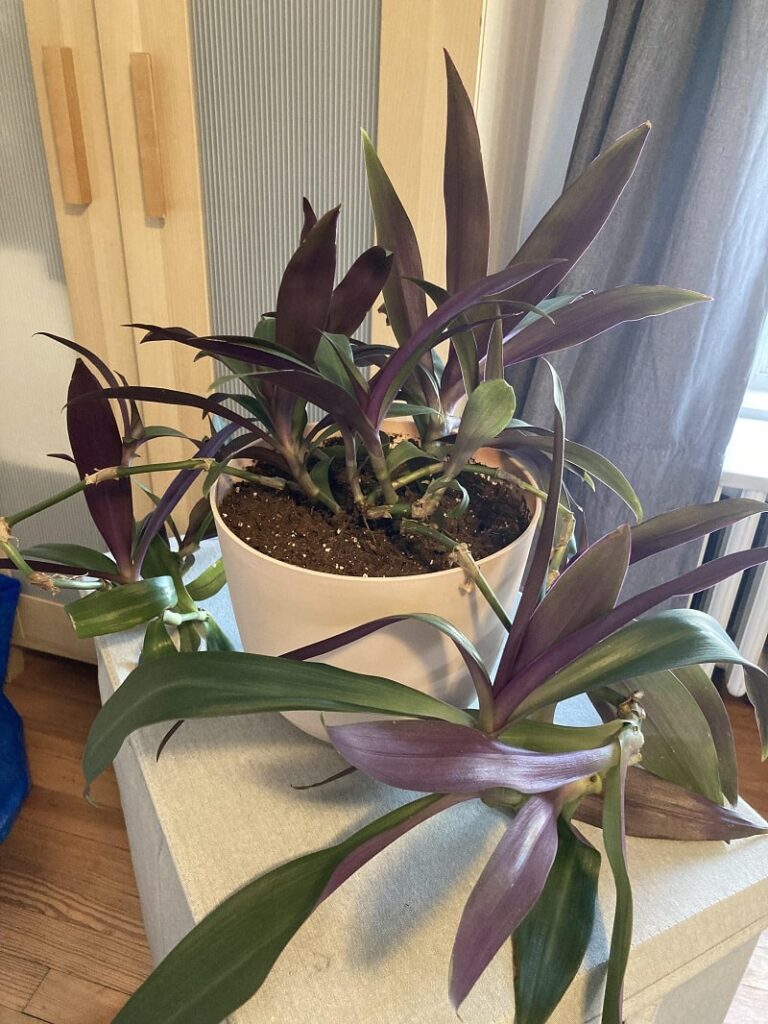The oyster plant (tradescantia spathacea) is an eye-catching indoor plant. This compact houseplant can also thrive outdoors in warm climates. Growing and caring for an oyster plant can be intimidating for beginners.
Oyster plant care regime involves the provision of bright indirect sunlight, well-draining soil, moderate to high humidity levels, and a temperature range of 55-80oF (13-27oC). Feed the plant monthly during spring and summer.
Continue reading this comprehensive guide to learn everything about the variegated oyster plant care routines. I’ve also highlighted the common oyster plant problems with their respective solutions at the end. Let’s find that out together in this tradescantia spathacea care sheet.
You May Also Enjoy: How to Grow and Care for Nerve Plant

What Does an Oyster Plant Looks Like?
The oyster plant (tradescantia spathacea) has long, lance-shaped, glossy, dark-green leaves with purple undersides. It also produces small white or pink flowers and forms a striking rosette.
The houseplant comes in several species with different foliage colors. Some leaves display variegations, and others show solid colors.
Oyster plants experience a fast growth rate and are ideal for growing during early spring. Tradescantia spathacea hails from Guatemala, southern regions of Mexico, and Belize.
The oyster plant is also called boat lily and Moses-in-the-cradle. The shape of flowers and canoe-shaped leaves are the reasons behind these names. The flowers also resemble oysters.
The oyster plant belongs to the genus tradescantia and has a relation to wandering jew and spiderwort plants. It belongs to the Commelinaceae family and herbaceous perennials.
An indoor tradescantia spathacea can reach 6-12 ft tall with green top leaves and purple undersides. The leaves can grow up to 6-12 inches long and form a spiral rosette pattern.
Common oyster plant varieties are tricolor oyster plant, dwarf oyster plant, and golden oyster plant. The tricolor oyster plant care is similar to the other varieties.
This oyster plant care indoor summary will help you have a quick overview of the plant. Take the time to read through the chart for guidance.
Oyster Plant Care Details
| Origin | Guatemala, Mexico, and Belize |
| Botanical Name | Tradescantia spathacea |
| Common Names | Moses in the cradle Oyster plant Boat lily Rhoeo Oyster plant |
| Maximum Growth (Approx.) | 6-12 ft tall |
| Light Requirements | Bright indirect sunlight. Can tolerate low-light condition though the leaves will be less vibrant. |
| Watering Needs | Soak the soil once the 2-3 inches of topsoil is dry. Cannot tolerate drought. |
| Soil Requirements | Fertile and well-draining potting soil. Get a mixture of compost, perlite, and potting soil. |
| Temperature Range | 65-85oF (18-29oC). A temperature below 55oF (13oC) will harm the plant. |
| Humidity Requirements | Above 40%. Thrives under moderate to the high humidity level. |
| Fertilizer Application | Low fertilizer requirement. Feed the plant monthly during the growing season. |
| Pruning and Maintenance | Remove old or dead leaves to maintain their shape and appearance. |
| Propagation | Remove the offsets and plant when about 4-inches tall. |
| Re-potting | After overgrowing the pot. |
| Pests and Diseases | Pests: Scales, mealybugs, and spider mites. Diseases: Root rot due to overwatering. |
| Toxicity | Non-toxic to pets and humans. |
How to Care for Oyster Plant (Tradescantia Spathacea)
Oyster Plant Soil Requirements
The boat lily plant prefers a fertile and well-draining potting mix. The soil should be slightly acidic or neutral to enhance growth and health.
Heavyweight and compact soil will result in root rot. Oyster plants love well-draining soil that never gets soggy after watering.
Combine equal parts of the potting mix, perlite, and compost to create your soil mixture. The perlite helps to improve drainage, and compost boost soil fertility.
Oyster Plant Light Requirements
The Rhoeo oyster plants develop solid foliage colorations under bright indirect sunlight. The location is the best option for tricolor oyster plant care.
Oyster plants can also tolerate low-light conditions. But the houseplant will end up losing the purple color and become greener. Use artificial lights when growing the plant in dark rooms.
Direct sunlight exposure will scorch the leaves. Besides that, this indoor plant will begin to wilt and become droopy. Relocate the plant to a place that receives bright indirect sunlight.
Temperature Range for Oyster Plant
Oyster plants are native to the tropical rainforest in warm and humid weather. Every houseplant enthusiasts need to replicate the condition at home.
The tradescantia spathacea can grow outdoors in frost-free locations. A temperature range of 55-80oF (13-27oC) is the best oyster plant care practice to consider.
Use a digital thermometer (Check the Best Deals on Amazon) to detect and monitor indoor temperature fluctuations. Position your houseplant away from heat and cold drafts.
How to Water an Oyster Plant
Oyster plants are forgiving tropical houseplants. These plants can relatively tolerate drought for an extended period without becoming fussy.
The plant will develop root rot under constant soggy soil. The root rot condition will make the houseplant die in the long run.
The golden rule is to inspect the soil moisture content before watering the houseplant. Insert the index finger in 2-3 inches of topsoil and soak it if dry.
Ensure the pot has several drainage holes at the bottom to get rid of excess water. Besides that, schedule a watering routine to avoid issues related to under-watering and overwatering.
Tradescantia Spathacea Humidity Needs
Moderate to high humidity level is the best oyster plant care practice. It helps the leaves to remain happy and healthy throughout the year.
Low humidity will turn the oyster leaf tips brown. Besides that, this indoor plant will become limp and droopy in the long run.
You can relocate your oyster to the bathroom if there is adequate light to enjoy the high humidity levels. Another option is to use an electric humidifier to increase indoor humidity.
Oyster Plant Fertilizer Requirements
The boat lily plants are light-feeders, but regular fertilizer application helps to enhance healthy growth. Use slow-release fertilizer to feed your houseplant monthly during the growing season.
Avoid feeding your oyster plant during winter due to the dormancy phase. It will help reduce the risk of burning the leaves due to excess salt buildup.
I recommend flushing the potting soil every three months to prevent salt buildup. Excess accumulation of salt might lead to brown leaf tips and burning.
Organic fertilizer is the best option due to the low risk of salt buildup and over-fertilization. It would be best to read my guide on How to Make Homemade Fertilizer for Houseplants.
Oyster Plant Pruning Needs
Oyster plants require minimal pruning requirements. Trim the old or damaged leaves to enhance their healthy-looking and compact shape.
Use a clean and sterilized hand pruner (Check Best Deals on Amazon) to avoid spreading plant diseases. Wipe the pruner blades with alcohol.

Oyster Plant Propagation
A mature oyster plant develops offsets that can be removed and re-potted. Pull the side shoot from the parent oyster plant to propagate a new plant.
Wait until the side shoot is about 4-5 inches tall before removing it from the parent plant. Plant the shoot in a new pot with a moist potting mix to develop roots.
You May Also Like: How to Care for Macodes Petola
Common Oyster Plant Problems and Solutions
Pests
The oyster plant is less vulnerable to pest infestation when compared to other tropical houseplants at home. But it does not imply that the oyster plants are invincible to insect infestations.
Mealybugs, whiteflies, scales, and spider mites are the leading sap-sucking creatures that attack most oyster plants. Examine the plant to identify the exact pest and spray with insecticidal soap.
Diseases
The oyster plant is relatively free from common plant diseases. But it is likely to develop root rot due to overwatering. The issue is due to poor soil drainage and lack of drainage holes below the pot.
Foliage turning yellow and oyster plant base becoming mushy is the initial sign of root rot. I recommend re-potting the houseplant to a fresh potting mix and reducing the watering frequency.
Frequently Asked Questions
Do Oyster Plants Bloom?
Yes. Oyster plants produce tiny flowers that remain tucked in the leaves. The flowers are white or purple due to different varieties and prevailing conditions.
Are Oyster Plants Poisonous?
No. The Oyster plant is non-toxic to humans and pets. But the leaves can cause severe burning in the mouth and throat after ingestion.
Why Is My Oyster Plant Dying?
Pests and diseases are possible causes of death. Other potential causes are direct sunlight exposure and inappropriate watering routine.
Why Does My Oyster Plant Have Brown Leaf Tips?
Too much direct sunlight, low humidity, and over-fertilization are the leading cause of brown leaf tips on oyster plants. Examine the houseplant to identify the exact cause and fix it.
Why Are the Leaves of My Oyster Plant Turning Brown?
Direct sunlight exposure and excess salt buildup around the roots are the possible causes of brown leaves on an oyster plant.
Flush the potting mix to eliminate excess salt and relocate the plant to a region that receives bright indirect sunlight.
Why Does My Oyster Plant Have White Spots on Leaves?
Tiny white spots on the leaves of an oyster plant are spider mites. These sap-sucking creatures drain nutrients from the leaves and damage vital tissues.
Use neem oil or insecticidal soap spray to eliminate the spider mites. Remember to isolate the oyster plant from other indoor plant collections to combat spreading the pests.
You May Also Read: How to Care for Lipstick Plant

Final Word
The oyster plant is ideal for those houseplant enthusiasts looking for a small and compact tropical houseplant. It requires minimal maintenance routines, and the foliages can pop any space.
The oyster plant leaves contain sap that can irritate the skin. But the flora is used for many medicinal purposes. The houseplant is non-toxic to pets and toddlers.
The iconic leaves with purple, green, pink, and white dots are the reason behind the popularity of this houseplant across the United States and Canada.
I hope this oyster plant care guide is helpful. Use the comment section to share your experience and questions regarding this impeccable indoor plant.
